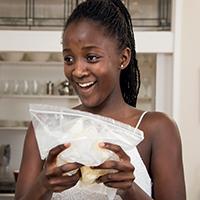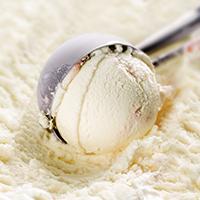Instant Ice Cream

Equipment & Ingredients
- One small zip-resealable sandwich bag
- One large zip-resealable plastic bag
- 120ml (1/2 cup) cream or full fat milk.
- 12.5g (1 Tbsp) sugar
- A few drops of vanilla or other flavouring of your choice
- 3-7 cups of ice
- 75g (5 Tbsp) salt
 Instructions
Instructions
- Add the cream, sugar, and vanilla to the small bag and seal, ensuring that any excess air is released.
- Place the ice, salt and cream-filled bag into the larger bag and seal.
- Vigorously shake the large bag over a sink for approximately 5 minutes. Stop when the cream has started to freeze and turn into a solid.
- Remove the small bag and quickly rinse off the salt solution with cold water.
- Pour the ice cream into a bowl, add your favourite toppings and enjoy eating your newly frozen dessert!
The Science Behind the Homemade Ice Cream
Ice cream is an emulsion, or a mixture of two liquids (water and fats) which do not normally mix together. To make ice cream, the milk or cream mixture needs to change its state from a liquid to a solid. If the mixture was simply placed straight into the freezer, the water component would freeze first, forming large, crunchy ice crystals. Ice cream tastes better when it is creamy rather than crunchy, so the goal in ice cream making is to create the smallest ice crystals possible. By vigorously shaking the bag, any large ice crystals that may be forming are broken up into smaller crystals, resulting in a smooth and creamy ice cream. The freezing point of ice is lowered by the addition of salt, so it starts to melt. As this ice melts it draws heat energy from its surroundings – including the cream mixture enclosed in the smaller bag – cooling it enough to cause the liquid cream emulsion to freeze, changing it from a liquid to a solid and forming ice cream. 
Explore Further
» What happens if you do not shake the bag vigorously when making the ice cream?
» If you put too much ice cream in your mouth, you may suffer from what is called ‘brain freeze’ or an ‘ice cream headache’. Placing your tongue on the roof of your mouth should stop the headache – why do you think this is?
» Taste the ice cream frozen, then taste it again when it has melted. One should taste much sweeter than the other – why do you think this is?
Dr Michelle Dickinson (MNZM) ‘prize winning nanotechnologist, researcher and educator’ has made it her life mission to make science and engineering accessible for all. Her new book The Kitchen Science Cookbook is packed full of fun ‘recipes’, each teaching an important scientific principle in a format that is perfect for parents and children to enjoy together. Available on Amazon.



